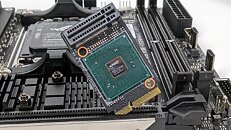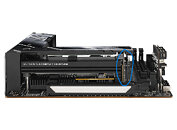- Joined
- Aug 19, 2017
- Messages
- 2,999 (1.07/day)
AMD's high-end X670E motherboard chipset combines two Promontory 21 chips working together to deliver a single solution. With regularly-sized ATX motherboards, having two chips to form a chipset is fine, as there is much room on the PCB. However, with Mini-ITX motherboards, packing two Promontory 21 chips is difficult as the PCB area is limited. To combat this, ASUS introduced an interesting solution to solve the problem and allowed the company to ship the high-end X670E chipset inside a Mini-ITX form factor. Thanks to UNIKO's Hardware's findings, we look at the exciting solution ASUS used to solve this problem.
Instead of two Promontory 21 chips side by side, one is placed on the motherboard directly, while the other stands vertically attached by M.2 PCIe slot. Below, the chipset's pictures and the highlight show how it looks disassembled.



View at TechPowerUp Main Site | Source
Instead of two Promontory 21 chips side by side, one is placed on the motherboard directly, while the other stands vertically attached by M.2 PCIe slot. Below, the chipset's pictures and the highlight show how it looks disassembled.



View at TechPowerUp Main Site | Source





